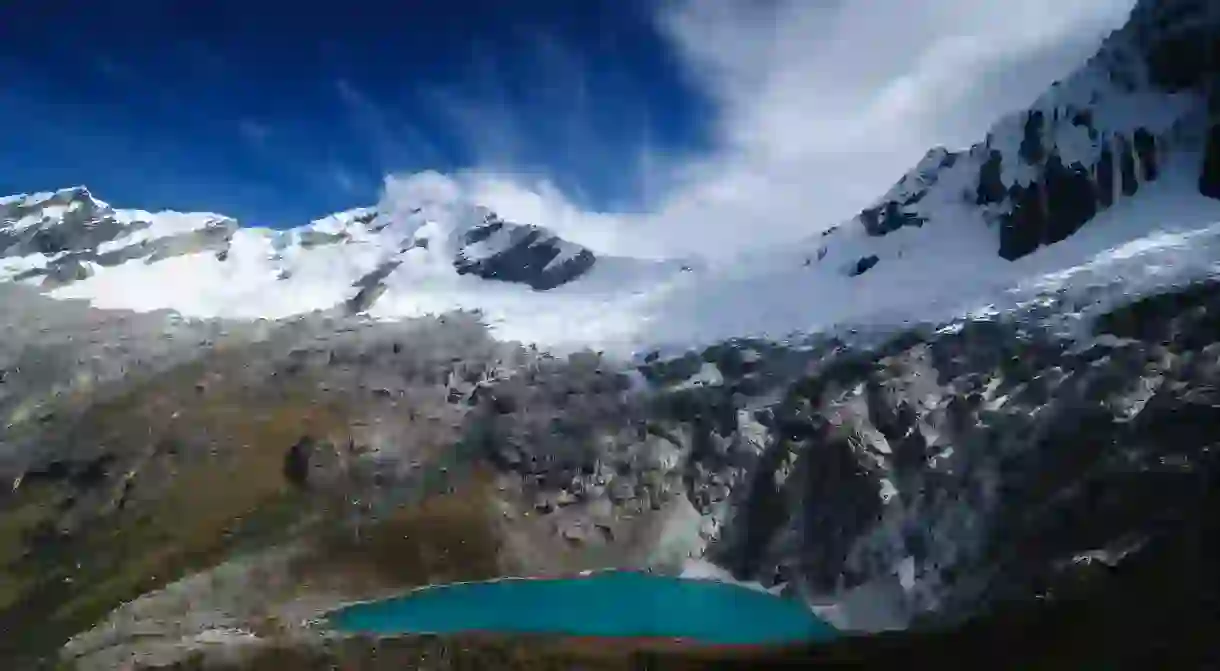Where To Spot Peru’s Brightest Turquoise Lakes

Home to six glaciers and countless snow-capped peaks, Peru is a paradise for picture-perfect, bright turquoise lakes. With good hiking boots, plenty of snacks and a little bit of determination, this guide will help you tick off some of Peru’s – and South America’s – most stunning glacial lagoons.
Cordillera Blanca
Rivaled only by the Himalayas, Peru’s Cordillera Blanca is the world’s second highest mountain range. Keen climbers and hikers flock here for the challenging trekking routes and stunning ice-capped mountain views, but the real draw are the turquoise and emerald lakes that lie around every corner.
Laguna 69
Undoubtedly the Cordillera’s most visited site, Laguna 69 boasts one of Peru’s brightest and clearest glacial lakes. Backed by towering snow-capped peaks and glistening waterfalls, this 15,000-foot (4,572-meter) turquoise gem is a sight that you have to see to believe. The path is well-trodden, but beware: due to the high altitude and several steep ascents, the Laguna 69 day hike is still considered to be challenging if you’re not acclimatized. Tours leave early in the morning and usually take in the pretty Llanganuco Lakes en route.

Lake Parón
Lake Parón is the biggest lake in the Cordillera Blanca and, like Laguna 69, its high levels of dissolved limestone give the water a ridiculously bright turquoise color. Unlike its popular sister lake Laguna 69, however, this trek has very few steep uphill climbs, making it a great option for those still acclimatizing to the altitude.

Llanganuco
Llanganuco is made up of two stunning lagoons: Chinancocha (female lagoon) and Orconcocha (male lagoon). Both are fed by the glacial waters of Peru’s highest peak, Huascarán, and they glisten (if the light is just right) with some of the brightest turquoise waters in the area. The best bit? As it’s a little more off-the-beaten track, Llanganuco sees far less footfall than Lake Parón and Laguna 69, which means that if you’re lucky, you may even get this slice of paradise to yourself.
Ausangate
Just a three-hour drive from Cusco lies one of Peru’s most stunning mountain ranges: la Cordillera de Vilcanota (more commonly known as Ausangate, after its highest peak). Most who come to this region are here to see Machu Picchu, which means the trekking routes that surround Ausangate, and its glacial lakes, are practically empty. All of the lakes mentioned below can be seen in most five- to six-day Ausangate circuit treks.
Lake Ausangate Q’ocha
Hidden somewhere between the peaks of Ausangate and Q’ampa, Lake Ausangate Q’ocha is a vivid blue lake surrounded by bright green mossy fields. It’s a long and challenging hike to get here, but the good news is that you’ll spot other beautiful turquoise and emerald green lagoons, such as Puqa Q’ocha and Jatun Puqa Q’ocha, en route. By day, the crystal-clear waters on these lakes reflect the snow-capped peaks that surround them and, by night, become giant reflection pools for a sky ablaze with stars.
Laguna Qomerqocha
If you continue high up into the Q’ampa Pass, below you’ll spot what looks like two huge glistening turquoise diamonds on the valley floor. This is the beautiful Laguna Qomerqocha. Sometimes bright turquoise, sometime milky-blue, this lagoon is probably the most iconic of the region. From here, you’ll most likely hike onto the town of Pacchanta, which will take you down past the lake for a closer look.
Salkantay
After the Inca Trail hike, the Salkantay route is one of the most popular trails in Peru. And it’s easy to see why: jagged snow-capped peaks, emerald-green mossy fields and, of course, those all-important dreamy lakes are just some of the reasons thousands of tourists flock here every year.

Humantay Lake
Believed to be one of the most sacred lakes in the region, Humantay has been the place for rituals, meditation and ceremonies for hundreds of years. When you see the majestic blue lake and its beautiful surroundings, it’s easy to understand why. If you’re on the Salkantay trek, you’ll make a stop here, and maybe even camp nearby. If you don’t fancy the multi-day trek, however, it’s also possible to visit the lake on a long day trip from Cusco.














